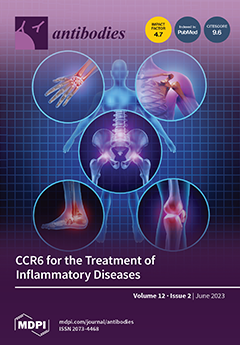CC chemokine receptor 6 (CCR6) is one of the members of the G-protein-coupled receptor (GPCR) family that is upregulated in many immune-related cells, such as B lymphocytes, effector and memory T cells, regulatory T cells, and immature dendritic cells. The coordination between CCR6
[...] Read more.
CC chemokine receptor 6 (CCR6) is one of the members of the G-protein-coupled receptor (GPCR) family that is upregulated in many immune-related cells, such as B lymphocytes, effector and memory T cells, regulatory T cells, and immature dendritic cells. The coordination between CCR6 and its ligand CC motif chemokine ligand 20 (CCL20) is deeply involved in the pathogenesis of various diseases, such as cancer, psoriasis, and autoimmune diseases. Thus, CCR6 is an attractive target for therapy and is being investigated as a diagnostic marker for various diseases. In a previous study, we developed an anti-mouse CCR6 (mCCR6) monoclonal antibody (mAb), C
6Mab-13 (rat IgG
1, kappa), that was applicable for flow cytometry by immunizing a rat with the N-terminal peptide of mCCR6. In this study, we investigated the binding epitope of C
6Mab-13 using an enzyme-linked immunosorbent assay (ELISA) and the surface plasmon resonance (SPR) method, which were conducted with respect to the synthesized point-mutated-peptides within the 1–20 amino acid region of mCCR6. In the ELISA results, C
6Mab-13 lost its ability to react to the alanine-substituted peptide of mCCR6 at Asp11, thereby identifying Asp11 as the epitope of C
6Mab-13. In our SPR analysis, the dissociation constants (
KD) could not be calculated for the G9A and D11A mutants due to the lack of binding. The SPR analysis demonstrated that the C
6Mab-13 epitope comprises Gly9 and Asp11. Taken together, the key binding epitope of C
6Mab-13 was determined to be located around Asp11 on mCCR6. Based on the epitope information, C
6Mab-13 could be useful for further functional analysis of mCCR6 in future studies.
Full article






